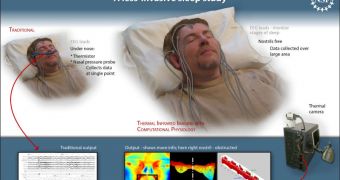Sleep apnea is a very widespread condition today, especially among people living in highly urbanized areas and subjected to large amounts of pollution. It is characterized by regular breathing stopping from time to time during sleep, mostly because of blockages that appear in the respiratory pathways. The reason why this is so dangerous is that it cuts the oxygen supply to the brain and other organs. The people who have the condition do not know that they are actually suffocating while they are sleeping. Now, a team of researchers has devised a new method of detecting the elusive condition.
In a paper published in the November issue of the respected journal Sleep, the Eckhard-Pfeiffer Professor of Computer Science at the University of Houston, Ioannis Pavlidis, and University of Texas Health Science Center (UTHSC) Division of Pulmonary Critical Care Sleep Medicine Assistant Professor of Medicine Jayasimha N. Murthy, describe a less invasive diagnosis method. At this point, polysomnography (sleep study) is the only method of detecting the condition, the experts say. Essentially, some people keep an eye on you as you sleep, and look for pauses in your breath.
“It's not as simple as paying a visit to the doctor in the morning for an hour and walking away with a prescription. You have to undergo overnight monitoring in a sleep lab. The subject is wired and sleeps there. Sometimes, the subject has to spend more than one night,” Pavlidis, who has also been a co-investigator for the new research, explains. “During a sleep study a subject has an average of more than 20 sensors attached to the head and body. It's a very complex procedure where many physiological parameters are simultaneously monitored to help in the diagnosis of sleep disorders. However, these sensors can disturb sleep and contribute to the patient's anxiety,” Murthy adds.
In the new method, a thermal infrared camera is used to detect the breathing waveforms that a patient produces as he or she sleeps. The airflow the breath creates is also analyzed, in a much less intrusive manner than that polysomnography uses. The next stage is to process the readings using computational algorithms. The research team says that investigations have demonstrated the fact that the diagnostics obtained with the new method are just as accurate as the ones obtained with sleep studies. The innovation therefore holds the potential of making millions sleep better and lead a healthier life.
“In contrast to the traditional one-dimensional methods, this new method is an imaging one and thus, multi-dimensional. We now can see how airflow is distributed locally throughout the extent of the nostril. We get not a single, but multiple values for each nostril at every point in time and this makes a lot of difference when it comes to appreciating subtle pathology,” Pavlidis concludes. Partial funding for the new research came from the US National Science Foundation (NSF).

 14 DAY TRIAL //
14 DAY TRIAL //